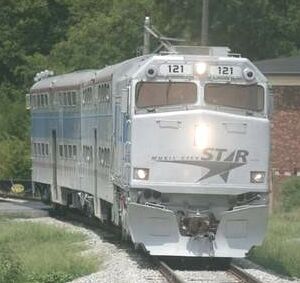 Nashville-area Music City Star train
Nashville-area Music City Star train(Photo: Alan Poizner)
Light Rail Progress can be contacted at: Light Rail Progress |
America's growing love affair with trains, it seems, continues to ... well, grow – with a new line opening in St. Louis's MetroLink light rail transit (LRT) system, and a whole new-start regional passenger rail (RPR) transit service (commonly called "commuter rail") starting up in Nashville. St. Louis: Ridership "soaring"
On the first full day of "normal" revenue service (Monday, 28 August), reported the St. Louis Post-Dispatch, "A steady stream of commuters boarded MetroLink trains all along the light-rail system's eight-mile Shrewsbury line ..." (although, as would be expected, the huge opening-day crowds had diminished somewhat). The paper focused on passengers whose commuting habits changed with the opening of the new line and its connections.
"Commuters embrace new MetroLink options" reported a later article in the Post-Dispatch (29 August).
"The new line means shorter commutes for many riders" noted the Post- Dispatch, citing the two passengers as examples.
"MetroLink has always offered a smooth train ride since it opened in 1993" noted the paper. "What it lacked was variety of destination." Now, that problem has diminished – a little. "The expanded line remains far from the dreamers' hopes of a big-city rail system" said the Post-Dispatch article. "But it does offer new advantages." The attraction of the new LRT service was reflected in a surge of ridership following the opening. "Metro ridership is soaring" reported a Metro News Release (1 September 2006), adding: "The first days of regular passenger service that included the new Shrewsbury Branch added more than 23,000 additional daily boardings when compared with the same period last year." Metro provided the following tabulation comparing MetroLink's average daily ridership from August 2005, actual ridership on Monday, 21 August 2006 (just a week before opening of the new branch), and actual ridership on August 28th and August 29th:
(Metro notes that a special event (a baseball game) impacted MetroLink's ridership numbers on 29 August.) And, says the News Release, the entire transit system has benefited from the successes of MetroLink and overall service improvements:
But mushrooming ridership may not even be the most significant impact of the new Cross-County extension. In its 28 August article, the Post-Dispatch relayed the views of Tom Shrout, executive director of the St. Louis regional transit advocacy organization Citizens for Modern Transit, who said he expects the new extension "will lead to a big increase in new transit users" such as those cited in the article. "But Shrout, who was surveying the morning rush at the Shrewsbury station, said the new line's biggest benefit might be measured in economic development." "We shouldn't just look at what happens today, but what happens in 10 or 20 years" Shrout told the paper. "There's going to be redevelopment up and down this corridor." Nashville launches the Music City Star
The $40 million line connects Nashville with the exurban community of Lebanon,
32 miles east of the city, making stops at four stations along the way – a total of a half-dozen altogether.
The Regional Transportation Authority (RTA), which has installed and now operates the line, reported that 345 riders hopped aboard trains on opening-day morning – taking at least several hundred motor vehicles off the area's crowded highways and arterials (and freeing up more parking in the central city). One-way fares range from $4.00 to $5.00, depending on the length of trip. According to an RTA cost comparative analysis, a weekday commuter from Lebanon to Nashville could save as much as $700 a month by taking the Music City Star rather than driving. Other benefits cited by RTA include:
The new service certainly seemed to be a hit with riders – at least, according to reports in the media.
"First-day riders enjoy Music City Star trek", reported The Tennessean [2006/09/19], adding that motorists who "hate" to commute were "happy to have [an] alternative".
Onboard the train, the reporter interviewed William Redmond, a state employee and resident of the exurb of Mt. Juliet, who "He was so eager to commute via the train that he purchased the first Music City Star ticket sold at Mt. Juliet City Hall."
Redmond, according to the paper,
thought Monday would never come, the day when he would hear the two words
that he believes will emancipate him from the perils and hassles of I-40 congestion: "All aboard."
For Redmond, according to the paper, Monday's call to passengers was "beautiful."
The Music City Star is just the first, relatively tiny step in what the RTA is calling the development of a Middle Tennessee Transit Network.
According to the RTA's website,
Commuters riding the train will enjoy a comfortable ride while saving on parking,
gas and automobile costs. This commuting alternative will not only result in
reduced stress for the commuter, it will reduce traffic congestion, improve air
quality, and encourage economic development in our region.
|
|
|
|
||